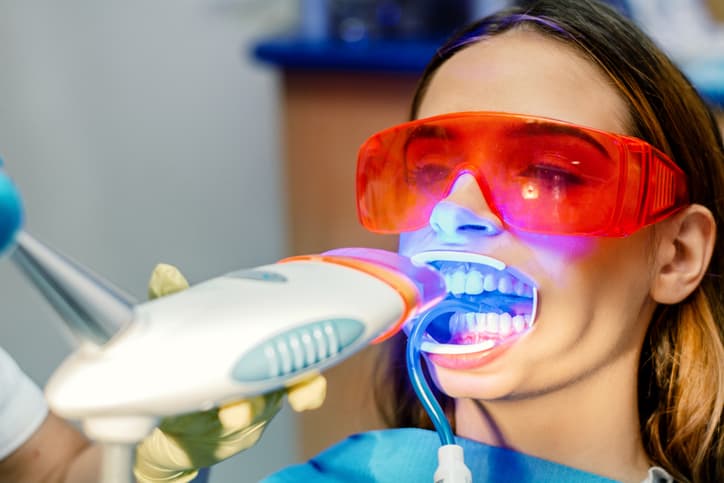 Want a brighter smile? When it comes to teeth whitening, you’ve got two options: in-office-based teeth bleaching, or at-home care.Both teeth whitening options use peroxide-based bleaching agents. At-home systems can contain from 3% to 20% peroxide (carbamide or hydrogen peroxides). In-office systems can contain from 15% to 43% peroxide.Generally, the longer you keep a stronger solution on your teeth, the whiter your teeth become. However, the higher the percentage of peroxide in the whitening solution, the shorter it should be applied to the teeth. Keeping the gel on longer can dehydrate the tooth and increase teeth sensitivity.
Want a brighter smile? When it comes to teeth whitening, you’ve got two options: in-office-based teeth bleaching, or at-home care.Both teeth whitening options use peroxide-based bleaching agents. At-home systems can contain from 3% to 20% peroxide (carbamide or hydrogen peroxides). In-office systems can contain from 15% to 43% peroxide.Generally, the longer you keep a stronger solution on your teeth, the whiter your teeth become. However, the higher the percentage of peroxide in the whitening solution, the shorter it should be applied to the teeth. Keeping the gel on longer can dehydrate the tooth and increase teeth sensitivity.
There are pros and cons to each option, but before you try at-home teeth bleaching kits, be sure to talk to your dentist. Not everyone will see good results. Bleaching will not whiten porcelain crowns or composite tooth-coloured bondings.
In-Office Tooth Whitening
Teeth whitening done by your dentist can get teeth brighter faster. The bleaching solution is usually much stronger than at-home kits. Also, heat, light, or a combination of the two may be used to speed and intensify the whitening process.
The most dramatic results — teeth generally get three to eight shades brighter — usually take several 30- to 60-minute in-office visits.
At-Home Teeth Bleaching Options
There are many choices for bleaching teeth at home, the most common include:
- Tooth whitening strips and gels. Applied directly to the teeth with a brush or a thin strip, these peroxide-based tooth bleaching products usually need to be applied once or twice a day for 10 to 14 days. Results last four or more months and may cost from $10 to $55. The downside to the strips is that they don’t always make great contact with your teeth, and can cause leakage of the whitening gel onto your gums and in your mouth.
- Tray-based tooth bleaching systems. With this teeth whitening option, a mouth guard-like tray is filled with a peroxide-based bleaching gel or paste and placed over the teeth for one to several hours a day for up to four weeks. You can buy tray-based tooth whitening systems over-the-counter or have one custom-fitted by your dentist. The cost can range from $150 to $600.
- Tooth whitening toothpaste. Because they’re mildly abrasive, every toothpaste helps remove stains from teeth. Whitening toothpaste, however, also contain chemicals or polishing agents that help scrub stains from teeth without the aid of a bleaching agent. Tooth-whitening toothpaste is relatively inexpensive and brightens teeth by about one shade. Some whitening toothpaste contains peroxides, but they aren’t left on the teeth long enough to have a whitening benefit.
Tooth Bleaching: Keeping Teeth White
Whether you use an at-home tooth-whitening system or have your teeth bleached by a dentist, you can help maintain the results by brushing, flossing, and rinsing daily. Also, avoid acidic and tannin-rich foods and beverages such as:
- Black teas and coffee
- White and red wine
- Sports drinks
- Carbonated beverages (dark and light-coloured sodas)
- Berries and other strongly-coloured foods
- Sauces (soy, tomato, curries)
Teeth Whitening: Why You Should Talk to Your Dentist
Tooth bleaching can make teeth temporarily sensitive — or be uncomfortable for people who already have sensitive teeth. When used incorrectly, home kits can also lead to burned — even temporarily bleached — gums.
To be sure tooth-whitening is worth your time and money, talk to your dentist before you use an over-the-counter tooth whitening kit.
